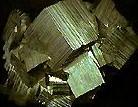
PERSONAL DETAILS:
MAIN PAGE:
SPOT PRICES:
DEPOSIT MODELS:
IDENTIFYING MINERALS:
CARBONATES:
HALIDES
NATIVE
ELEMENTS:
OXIDES:
SILICATES:
SULPHATES:
SULPHIDES:
LINKS:
SIGN
GUESTBOOK:
View Guestbook:
View Old Guestbook:


Galena: Lead Sulphide (copyright theimage.com)
cleavage and a hardness of 2.5. Galena is a typical hydrothermal mineral of medium temperature deposits where it is often associated with sphalerite, quartz and flourite. It can also be found in sedimentary and metamorphic rocks through the circulation of water and the replacement of pre-exisiting rocks. World class deposits can be found in the USA (Missouri, Oklahoma and Kansas), Australia (Broken Hill), Mexico and West Germany.

Chalcopyrite: Copper Iron Sulphide (copyright theimage.com)
metallic lustre. Hardness is between 3.5 and 4 which is softer than pyrite (a diagnostic feature
between the two). Chalcopyrite is common in high-medium temperature hydrothermal veins with pyrrhotite, pyrite and sphalerite. It is also found in mafic volcanics which have undergone some metamorphism (porphyry coppers) and contact metamorphism (skarns). World class deposits
found in the USA (Arizona, Bingham), Canada (Sudbury) and Chile.

Pyrite: Iron Sulphide (copyright theimage.com)
Crystals are cubic often with striations parallel to the cube edges but can also be octahedrals, pyritohedras and massive in form. Cleavage is indistinct and hardness ranges from 6-6.5. Common in medium-low temperature hydrothermal veins either on its own or with gold, sphaleite or galena. Also found in sedimentary rocks, especially black shales where it often replaces fossils. World class deposits in Spain, USA (Arizona, Colorado), Italy and Norway. veins
of sulphur and is used in the production of sulphuric acid .

Sphalerite: Zinc Sulphide (copyright theimage.com)
yellow, green or colourless. Lustre can be resinous or adamantine. Crystals are tetrahedral or dodecahedral often with rounded edges but it can also be found in massive and botryoidal forms. Cleavage is perfect parallel to the dodecahedran and hardness ranges from 3.5-4. Sphalerite
occurs in hydrothermal veins associated with galena, chalcopyrite and flourite and low-high
temperature replacement deposits, such as skarns. World class deposits in the former Yugoslavia (Tepca), Hungary (Kapnik), Italy and USA.

Molybdenite: Molybdenum Sulphide (copyright theimage.com)
with a hexagonal outline, forming bladed, foliated or scaly masses. Molybdenite is very soft with a
hardness of 1-1.5 and exhibits a prefect parallel cleavage. Molybdenite is generally found in
granites, pegmatites and sometimes diorites associated with cassiterite, scheelite and flourite. It is
also associated with contact metamorphic deposits i.e skarns. World class deposits have been
found in USA (Colorado, Ogden mine New Jersey), Australia, Italy and Norway.

Arsenopyrite: Iron Arsenic Sulphide (copyright theimage.com)
It has not been my intention to break any copyright rules, however, if I have stepped on someones toes, please Email me and I will be more than happy to rectify the situation.
